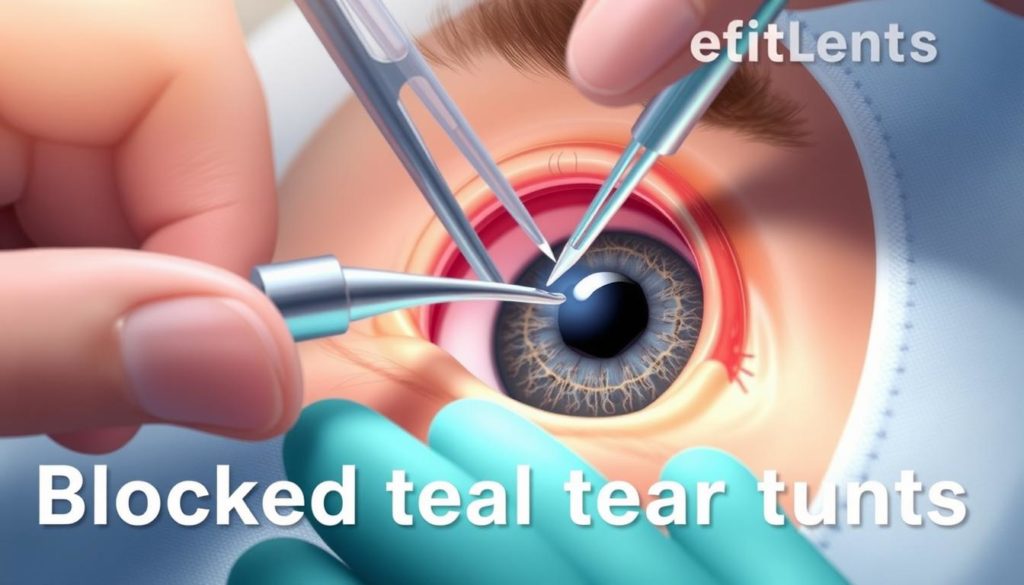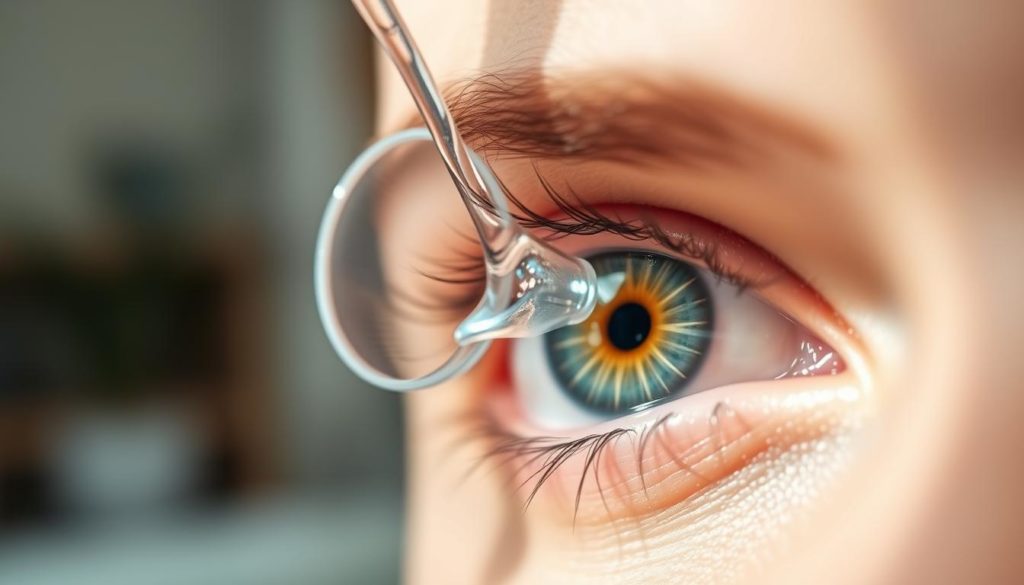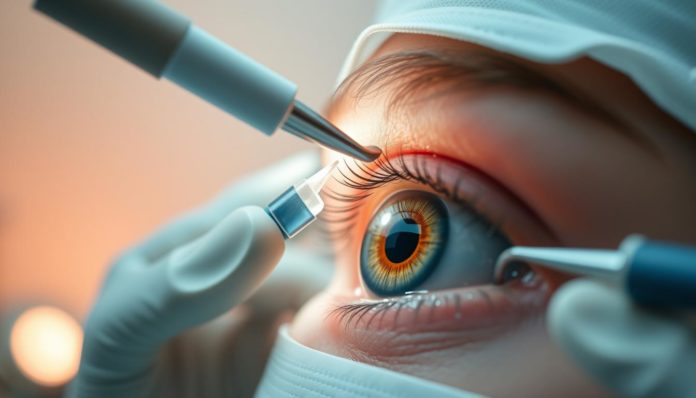Did you know up to 20% of newborns are born with blocked tear ducts? This shows how common it is. It affects people of all ages, causing discomfort and eye problems. Finding the right treatment is key to feeling better and seeing clearly again.
There are many ways to treat blocked tear ducts, from non-surgical to surgical methods. We’ll look at all the options, from home remedies to advanced medical treatments. This will help you choose the best way to feel better and see well again. Let’s explore the most effective treatments together.
Understanding Blocked Tear Ducts
Tear ducts play a key role in eye health. When they get blocked, it can cause a lot of discomfort. This section will explain what a blocked tear duct is, why it happens, and how to spot it. We’ll also look at how doctors diagnose and treat it.

What is a Blocked Tear Duct?
A blocked tear duct happens when the tear drainage system gets blocked. This stops tears from draining properly. It can make your eyes watery and irritated because the tears have nowhere to go.
Causes of Tear Duct Blockages
There are many reasons why tear ducts can get blocked. These include:
- Congenital factors
- Infections like conjunctivitis
- Injuries to the nose or eyes
- Age-related narrowing of the tear ducts
- Inflammation from chronic eye diseases
Finding out why it happened is key to choosing the right treatment.
Symptoms and Diagnosis
Knowing the symptoms and diagnosis of a blocked tear duct is important. It helps you get medical help quickly. Common signs include:
- Excessive tearing or watery eyes
- Recurring eye infections
- Swelling and redness in the corner of the eye
- Pain around the eyes or nose
Doctors use eye exams and imaging tests to diagnose it. Accurate diagnosis helps pick the best treatment.
Non-Surgical Treatment for Blocked Tear Ducts
If you have a blocked tear duct and don’t want surgery, there are good options. You can try warm compresses, massage, and antibiotic eye drops or ointments.
Warm Compresses
Warm compresses can really help with blocked tear ducts. Just soak a clean cloth in warm water, wring it out, and put it over your closed eyes for 5-10 minutes. The warmth helps to clear out blockages and helps fluid drain through the ducts.

Massage Techniques for Tear Duct Blockage
Massage can also help with blocked tear ducts. Gently massaging the area around the duct can clear blockages. Use your index finger to apply gentle pressure at the corner of your eye, moving towards your nose. Do this several times a day to help the duct work better.
Antibiotic Eye Drops or Ointments
If an infection is causing your blocked tear duct, antibiotic eye drops or ointments can help. These medications fight off bacterial infections that might be causing the blockage. Always talk to an eye care professional for a prescription and to learn how to use these treatments correctly.
Surgical Options for Blocked Tear Ducts
When non-surgical treatments don’t work, several surgical options are available. Each method has its own benefits and is suited for different patients. Let’s look at four common surgical options for blocked tear ducts.
Probing and Irrigation
Probing and irrigation is a common surgical option. It uses a thin probe to open the blockage in the tear duct. Then, a saline solution is used to clean the duct. This method is often used for infants but can also help adults.
Balloon Dacryoplasty
Balloon dacryoplasty uses a small balloon to widen the tear duct. The balloon is inserted through the nostril and inflated to open the duct. This procedure is less invasive and works for those who haven’t tried other treatments.
Dacryocystorhinostomy (DCR)
Dacryocystorhinostomy, or DCR, creates a new tear drainage pathway. It’s used when other treatments fail. DCR can be done with a small incision or endoscopically, leading to less scarring and faster recovery.
Stenting and Intubation
Stenting and intubation involve placing a tube or stent in the tear duct. This keeps the duct open and helps with drainage. It’s often used with DCR to improve success rates.
In summary, the options for blocked tear ducts include probing and irrigation, balloon dacryoplasty, dacryocystorhinostomy, and stenting and intubation. These methods offer effective solutions for those with tear duct obstructions. Talk to your healthcare provider to find the best option for you.
Blocked Tear Duct in Infants Treatment
Finding the right way to treat a blocked tear duct in infants is key. It’s about knowing when to get medical help and trying home care and non-surgical methods. Parents often struggle with this common issue. But with the right information, they can handle it well.
When to Seek Medical Help
It’s important to know when to get medical help for a blocked tear duct in infants. Look out for signs like too much tearing, red eyes, or eye infections that keep coming back. If these problems last more than a year or show signs of infection, get help right away.
Home Care and Non-Surgical Options for Infants
Home care and non-surgical treatments can work well for blocked tear ducts in infants. One common method is to gently massage the tear duct to help it drain. Use clean fingers to apply light pressure from the inside of the eye to the nose. This can help clear the blockage and improve tear flow.
- Warm Compresses: Warm compresses a few times a day can help relax the area and open the duct.
- Proper Hygiene: Keeping the eye area clean and washing hands before touching the baby’s face can prevent infections.
- Antibiotic Eye Drops: If a doctor suggests, antibiotic eye drops can help with infections along with the blockage.
Using these non-surgical methods, many infants find relief without needing surgery. But if problems don’t go away, it’s crucial to get medical help to avoid serious issues.
Adult Blocked Tear Duct Treatment
Adults with blocked tear ducts face different symptoms and causes than babies. These differences come from age, health issues, and the environment.
Symptoms and Causes Specific to Adults
Adults with blocked tear ducts may have ongoing tearing, eye infections, and eye inflammation. They might also see blurry vision and have mucus in their eyes. Causes include tear duct narrowing with age, sinus infections, and facial injuries.
Home Remedies vs. Medical Treatments
Adults can try home remedies like warm compresses and eyelid cleaning. Gentle eye massage can also help. But, these might not fix the problem for good.
For a lasting fix, medical treatments like balloon dacryoplasty and DCR are better. These are chosen when home remedies don’t work. Seeing an ophthalmologist is key to finding the right treatment for you.
Best Treatment for Nasolacrimal Duct Obstruction
Looking for the best treatment for nasolacrimal duct obstruction? You have many options. These range from simple methods to more complex surgeries.
First, try warm compresses and massage techniques. They help ease symptoms and clear blocked ducts. These are good for mild cases.
For tougher cases, surgery might be needed. Procedures like Probing and Irrigation use a thin tool to open the duct. Balloon Dacryoplasty inflates a balloon to widen it.
For chronic or complex cases, advanced surgeries are best. Dacryocystorhinostomy (DCR) creates a new tear drainage path. Stenting and Intubation use small tubes to keep ducts open.
| Treatment Type | Description | Effectiveness |
|---|---|---|
| Warm Compresses | Application of heat to the affected area | Moderate |
| Massage Techniques | Manual pressure to unblock ducts | Moderate to High |
| Probing and Irrigation | Inserting an instrument to unblock ducts | High |
| Balloon Dacryoplasty | Inflating a small balloon to widen ducts | High |
| Dacryocystorhinostomy (DCR) | Creating a new tear drainage pathway | Very High |
| Stenting and Intubation | Using tubes to keep ducts open | Very High |
Choosing the right treatment depends on the blockage’s severity and your needs. An ophthalmologist can guide you. They’ll find the best approach for you.
Blocked Tear Duct Massage Treatment
Massage can help if you have a blocked tear duct. It can open the ducts and help tears drain properly. We’ll show you how to do it and how often and long to do it.
How to Perform Effective Massage Techniques
First, wash your hands well to avoid infection. Use your index finger to press gently on the area below your eye’s inner corner. This is where the tear duct is. Move your finger in circles while applying pressure to clear blockages.
“Consistent and gentle pressure is key to an effective massage for tear ducts. If performed correctly, it can significantly reduce symptoms.”
- Step 1: Wash hands thoroughly.
- Step 2: Locate the tear duct (below the inner corner of the eye).
- Step 3: Apply gentle pressure with your index finger.
- Step 4: Move in a gentle, circular motion for up to 10 seconds.
Frequency and Duration
Do the massage 2 to 3 times a day for best results. Each massage should last 5 to 10 seconds. Regular massages help keep the tear duct open and ensure tears drain well.
| Parameter | Recommended Value |
|---|---|
| Massage Frequency | 2-3 times daily |
| Duration per Session | 5-10 seconds |
How to Fix a Blocked Tear Duct in Adults
Dealing with a blocked tear duct can be really annoying for adults. But knowing how to fix a blocked tear duct in adults can help you feel better. Start with simple home remedies that are easy to do.
First, try using a warm compress on your eye a few times a day. This can help open up the blocked duct. It increases blood flow and eases pain, making it a good fix for mild cases.
Another good home remedy is to massage the tear duct. Use circular motions to press on the area between your eye and nose. Do this often to get the best results.
If these home remedies don’t work, you might need to see a doctor. Adults have several treatment options, including:
- Probing and Irrigation: A simple method where a thin tool clears the blockage.
- Balloon Dacryoplasty: This involves using a tiny balloon to open the duct.
- Dacryocystorhinostomy (DCR): A surgery that creates a new tear duct opening.
- Stenting and Intubation: Temporary tubes or stents are used to keep the duct open.
Here’s a comparison of these treatments to help you decide:
| Procedure | Effectiveness | Recovery Time | Invasiveness |
|---|---|---|---|
| Probing and Irrigation | High | Short | Low |
| Balloon Dacryoplasty | Moderate | Moderate | Moderate |
| Dacryocystorhinostomy (DCR) | High | Long | High |
| Stenting and Intubation | Moderate | Moderate | Moderate |
Knowing about these options can help you choose the best way to fix a blocked tear duct in adults.
Preventative Measures for Tear Duct Blockages
Knowing how to prevent tear duct blockages is key. Keeping your eyelids clean is a big step. Use a warm, gentle compress to wipe away dirt and stop infections. This easy habit can greatly improve your eye health.
Your surroundings also matter a lot. If your area is dusty or smoky, air purifiers can help. Wearing sunglasses protects your eyes from wind and dust. Drinking enough water is also important for your eyes and tear production.
Don’t forget the importance of regular eye exams. A thorough check-up by an eye doctor can spot problems early. Catching issues early makes treatment easier and keeps your eyes healthy.
FAQ
What is a Blocked Tear Duct?
A blocked tear duct happens when the tear duct gets blocked. This blockage stops tears from draining into the nose. It can cause tearing, infections, and eye discomfort.
What are the common causes of tear duct blockages?
Several things can cause a blocked tear duct. These include being born with it, infections, injuries, and age. Even conditions like sarcoidosis can cause blockages.
What are the symptoms and how is it diagnosed?
Symptoms include too much tearing, eye infections, swelling, and discharge. Doctors use exams, tests, and scans like X-rays or CT scans to diagnose it.
What are the non-surgical treatments for blocked tear ducts?
Non-surgical treatments include warm compresses and massage. Antibiotic eye drops or ointments are used for infections.
How is a blocked tear duct treated surgically?
Surgery includes probing, balloon dacryoplasty, and DCR. Each has its own recovery time and risks.
What should I know about treating a blocked tear duct in infants?
Infants often have blocked tear ducts at birth. They usually open by themselves in the first year. Home care includes gentle massage and warm compresses. If it doesn’t open, medical help might be needed.
What are the symptoms and causes of tear duct blockages in adults?
Adults may have persistent tearing, eye infections, and swelling. Causes include aging, infections, or trauma.
What is the best treatment for nasolacrimal duct obstruction?
Treatment depends on the blockage’s cause and severity. Options range from conservative methods to surgery. Recent studies show minimally invasive procedures are effective.
How do you perform effective massage techniques for a blocked tear duct?
Use your clean finger to gently press the inner corner of the eye. Move it down towards the nose. Do this a few times a day for a few minutes each time. Consistency is key.
What are the methods to fix a blocked tear duct in adults at home?
Home methods include warm compresses, massage, and good eye hygiene. If these don’t work, see a doctor for more options.


